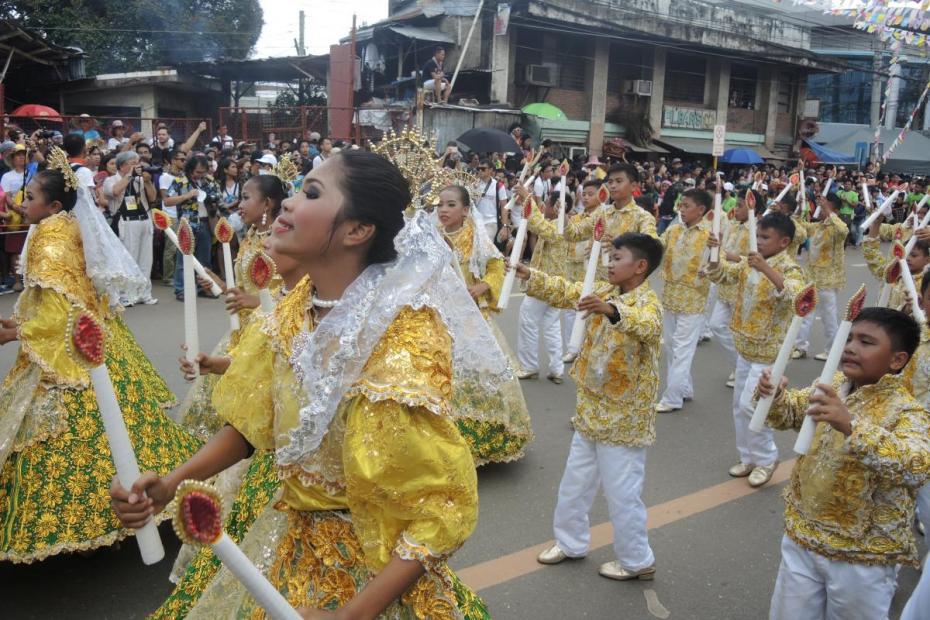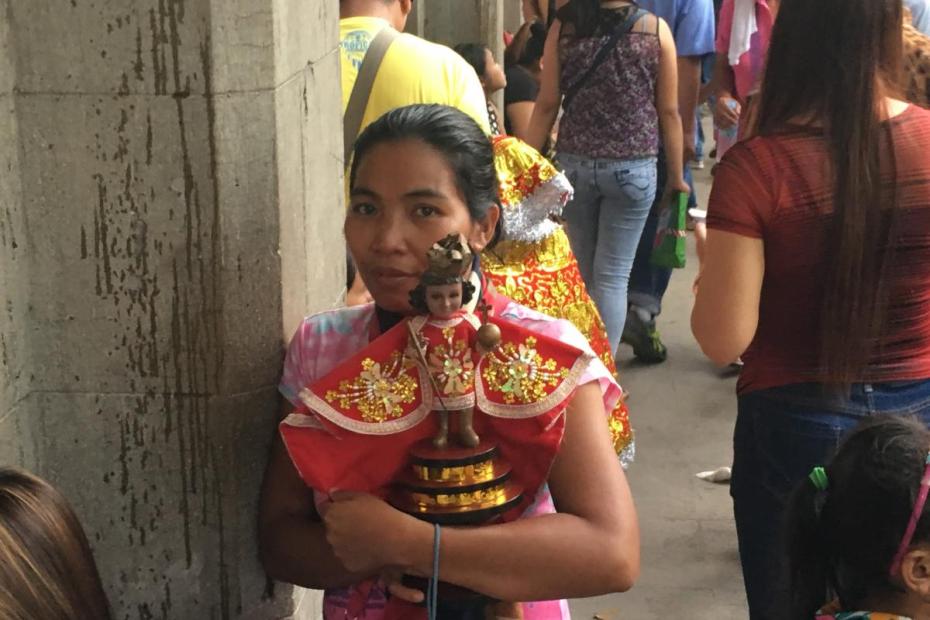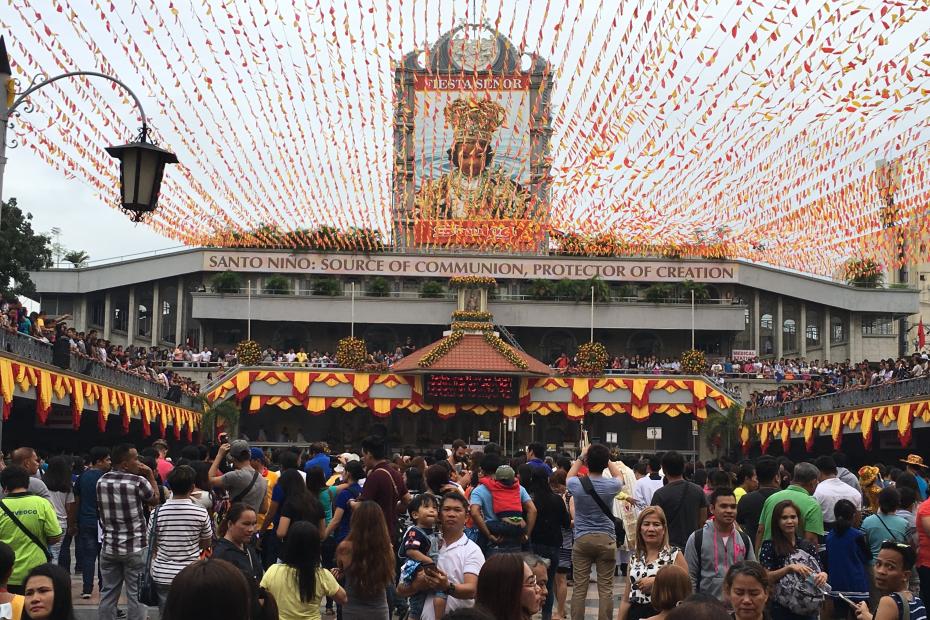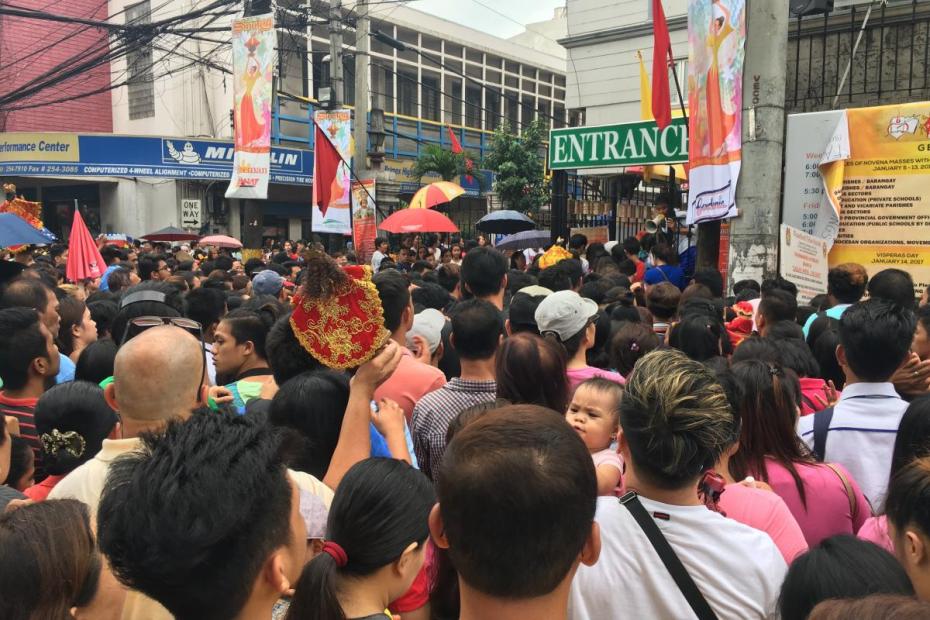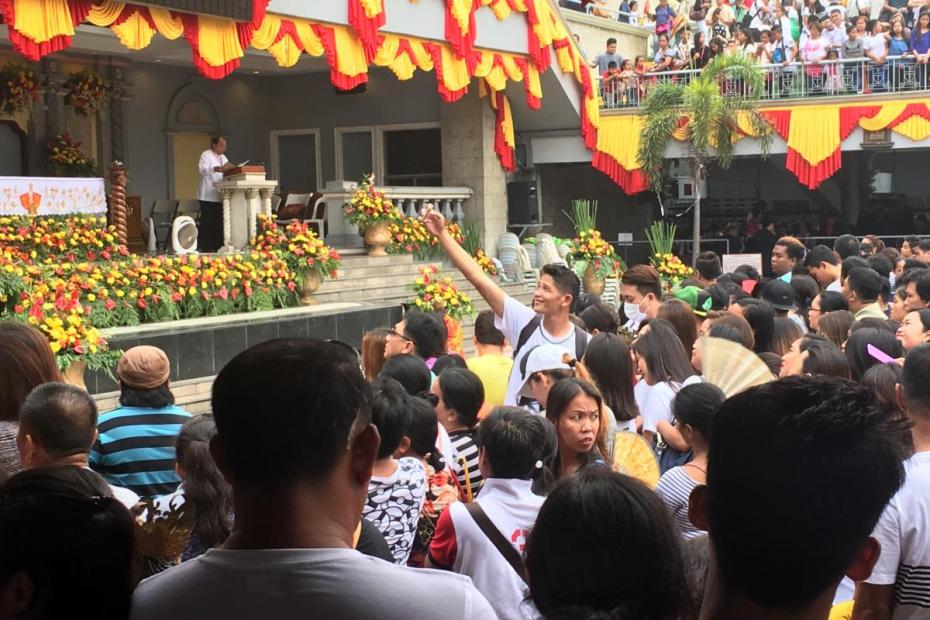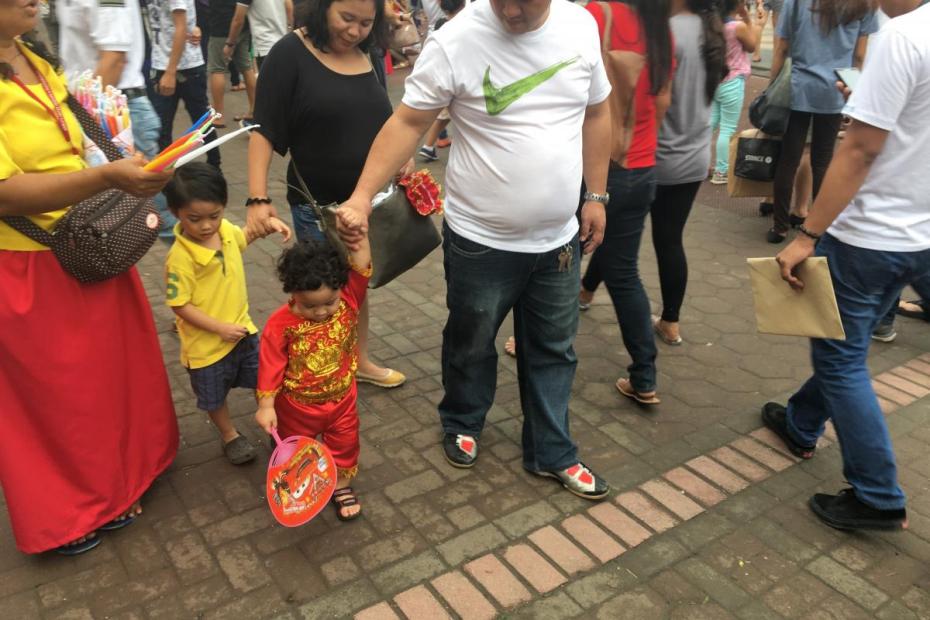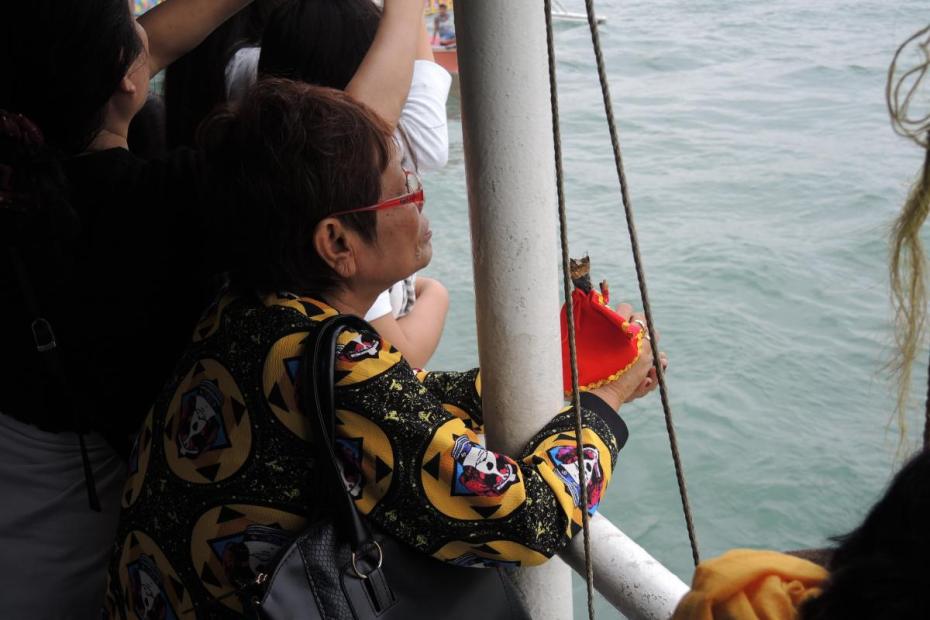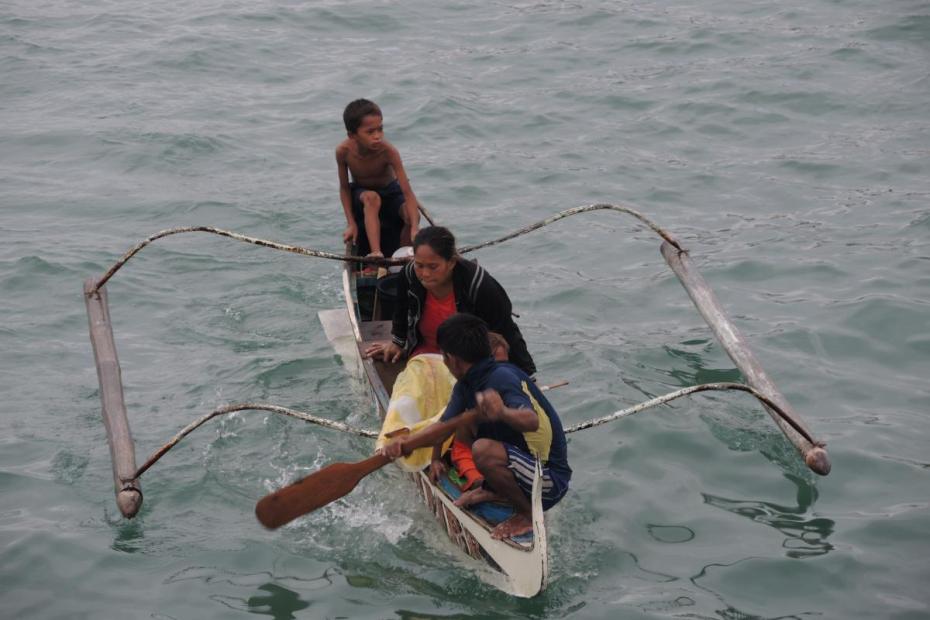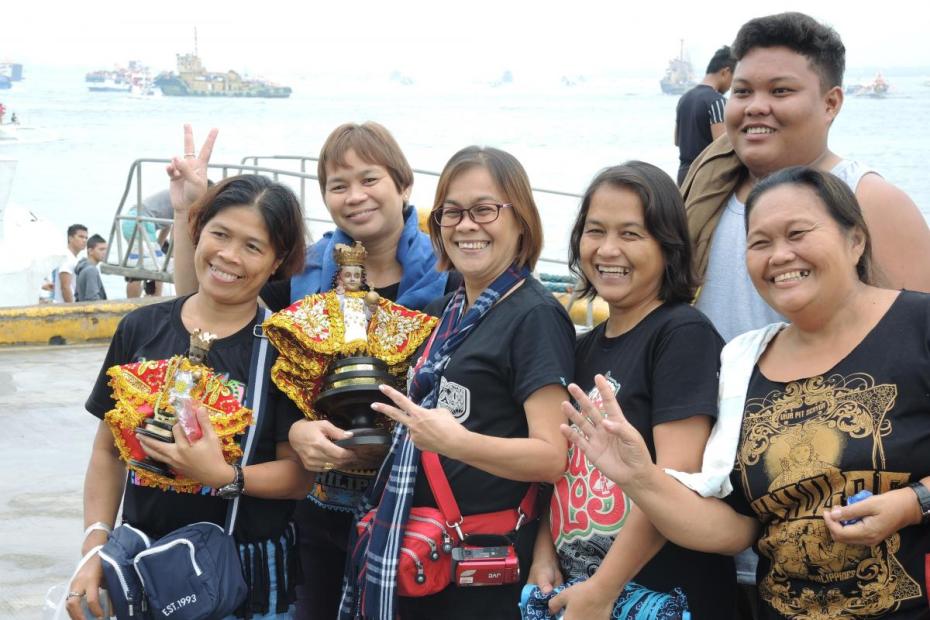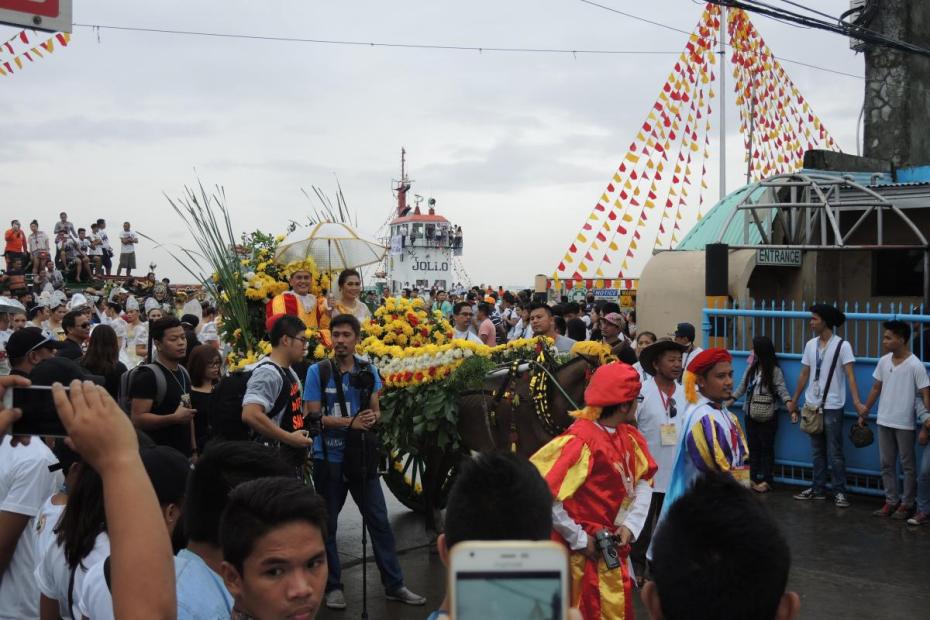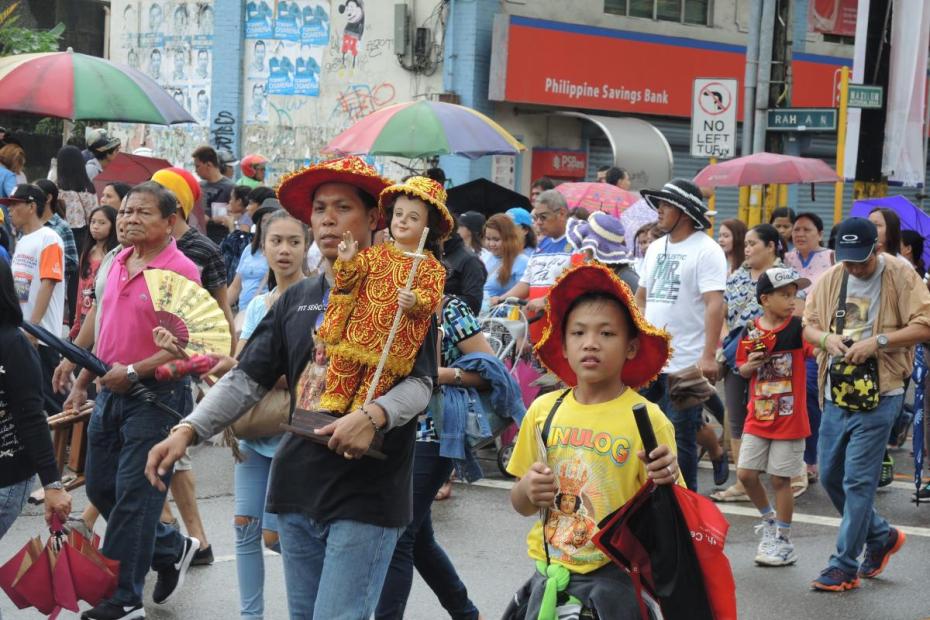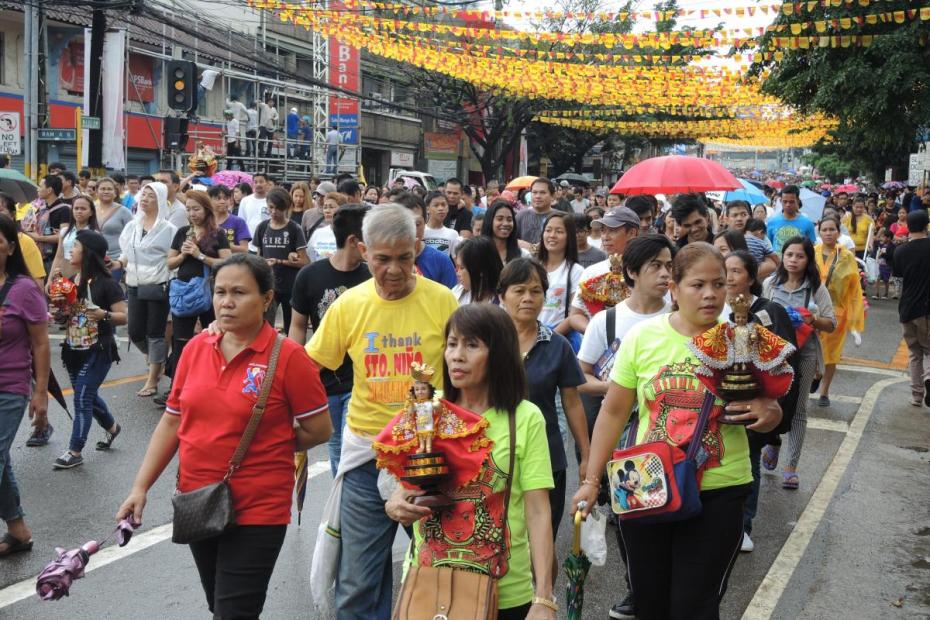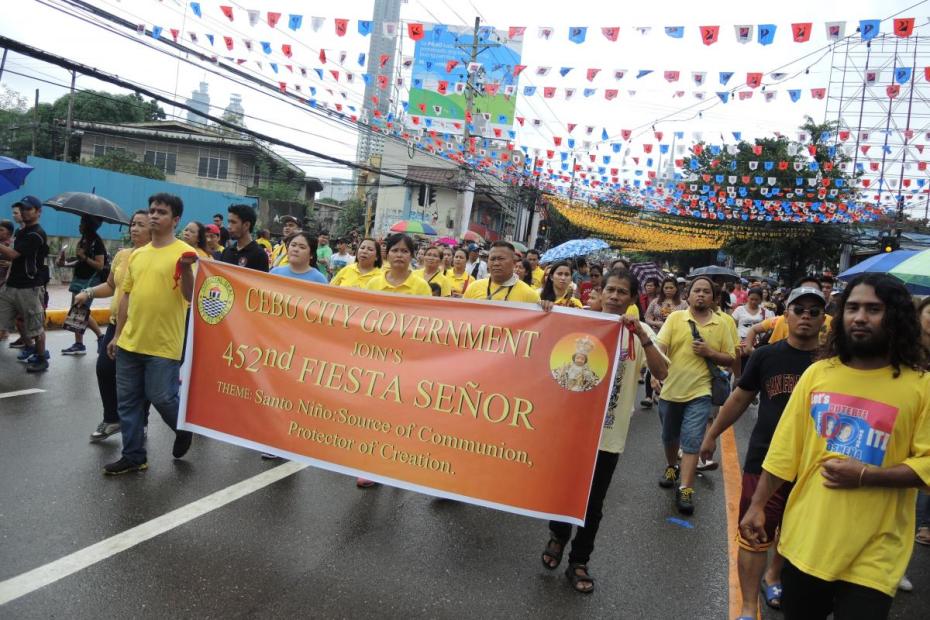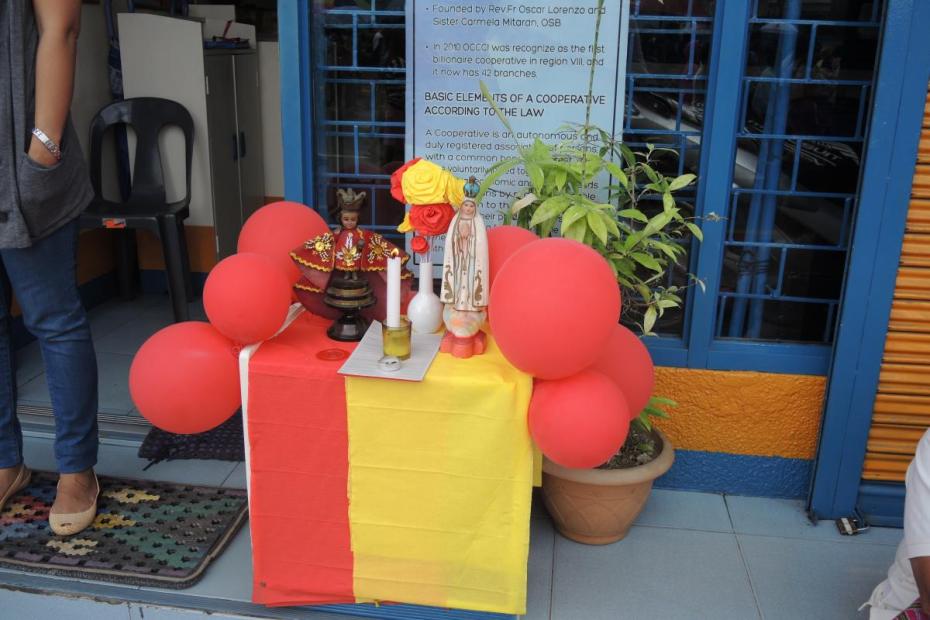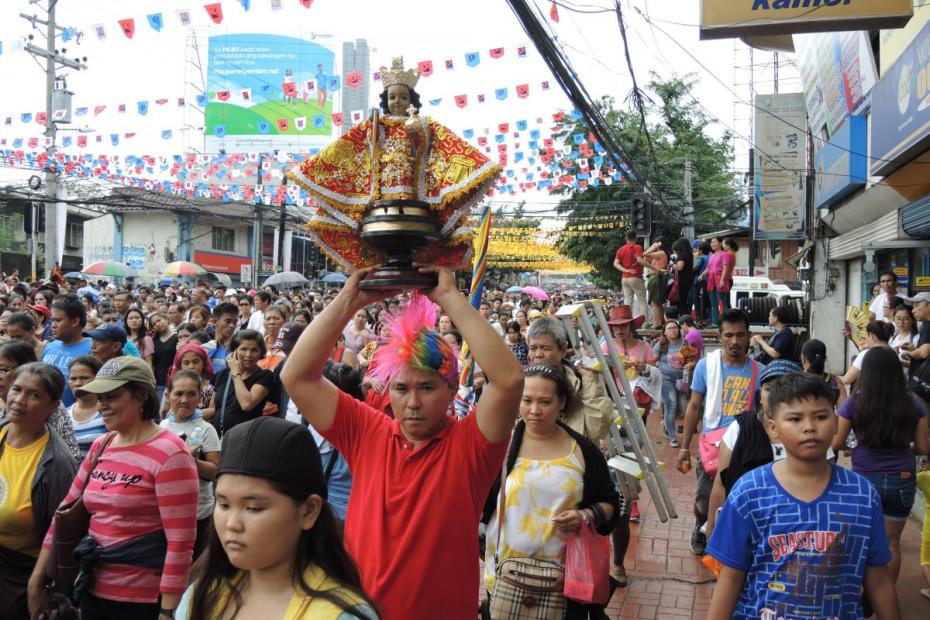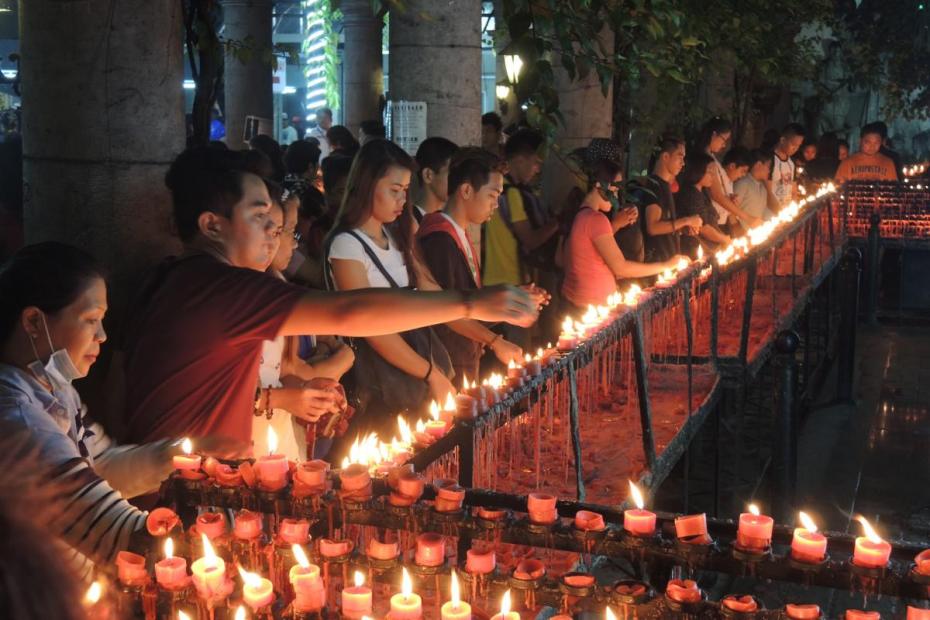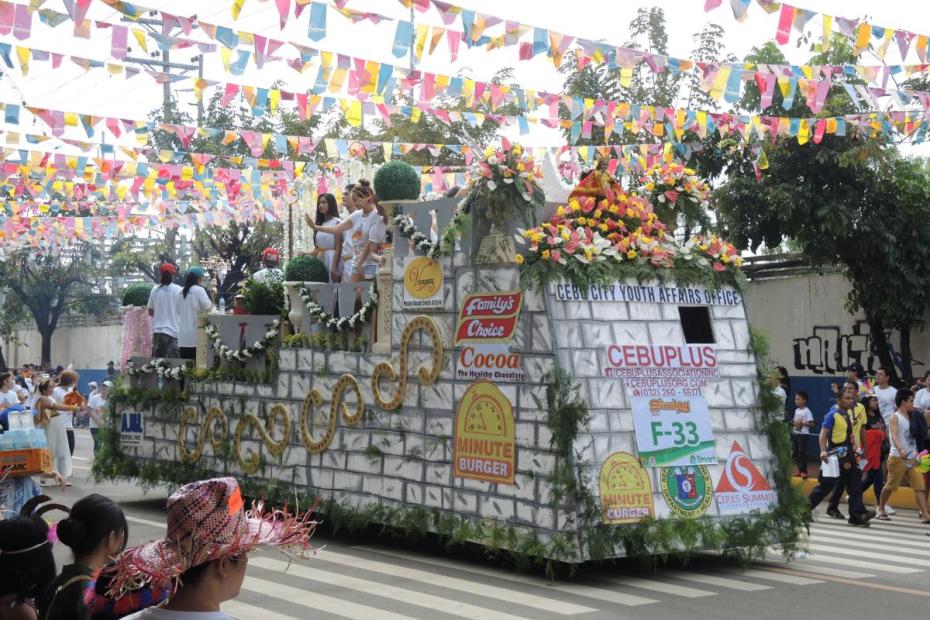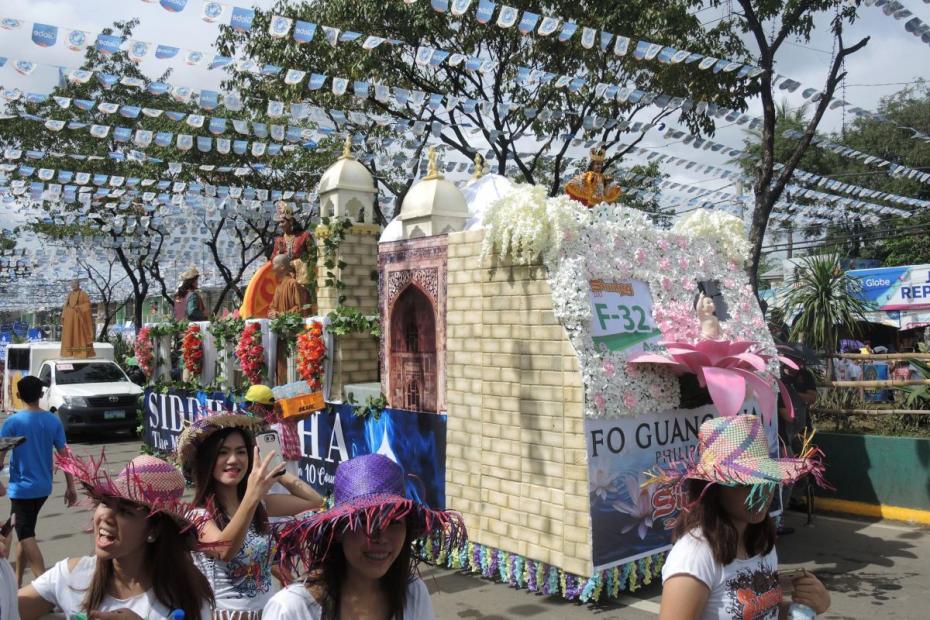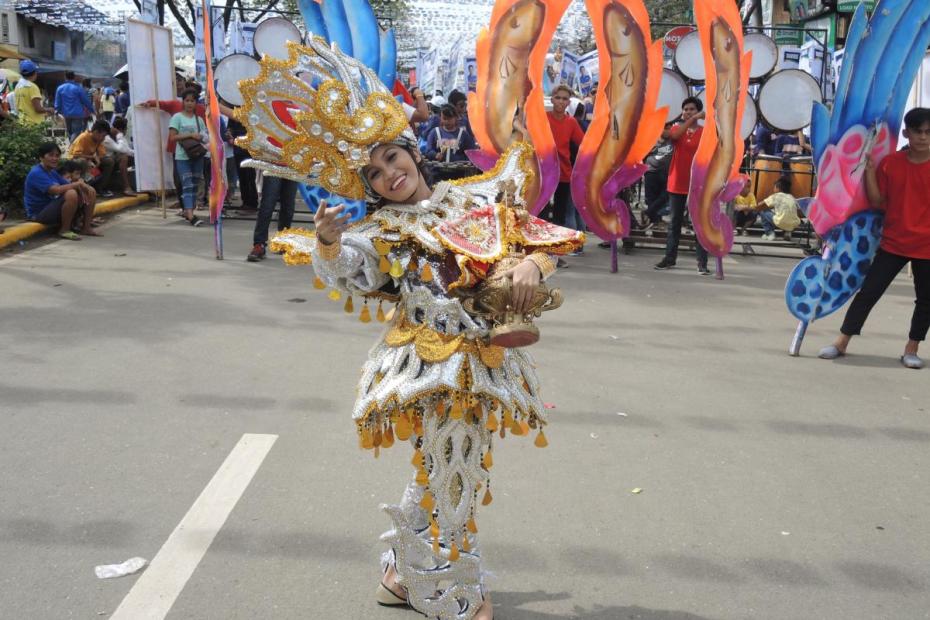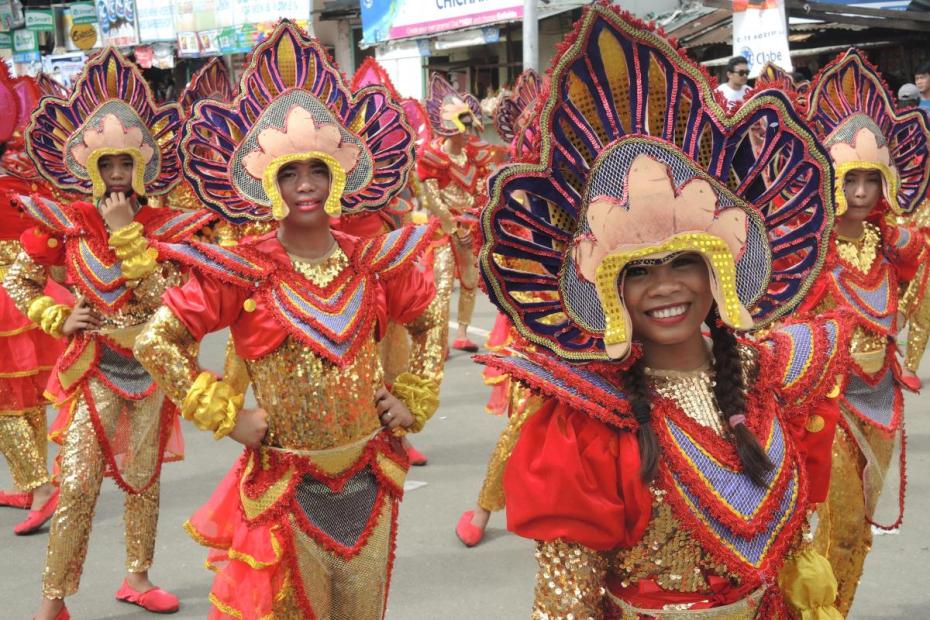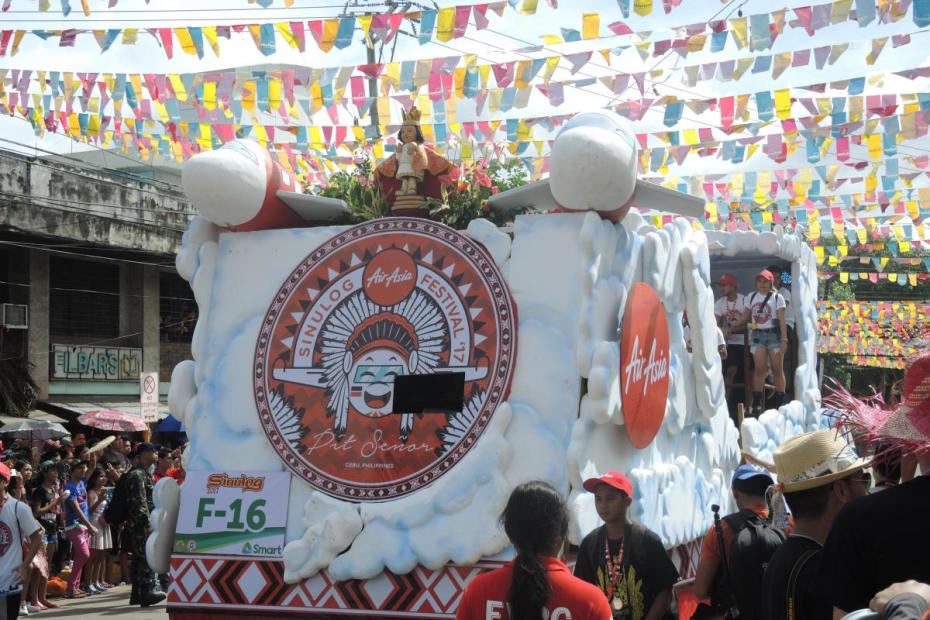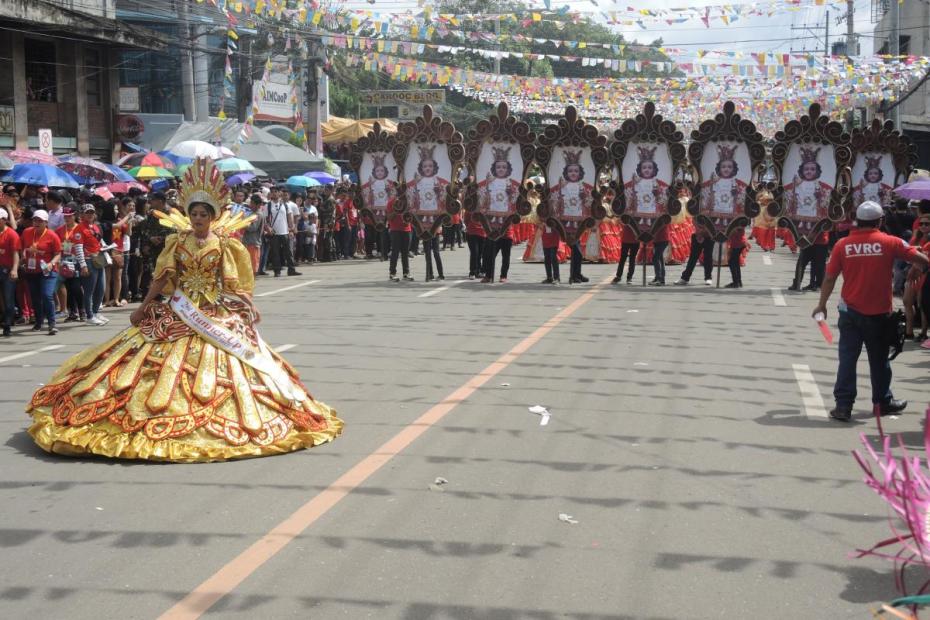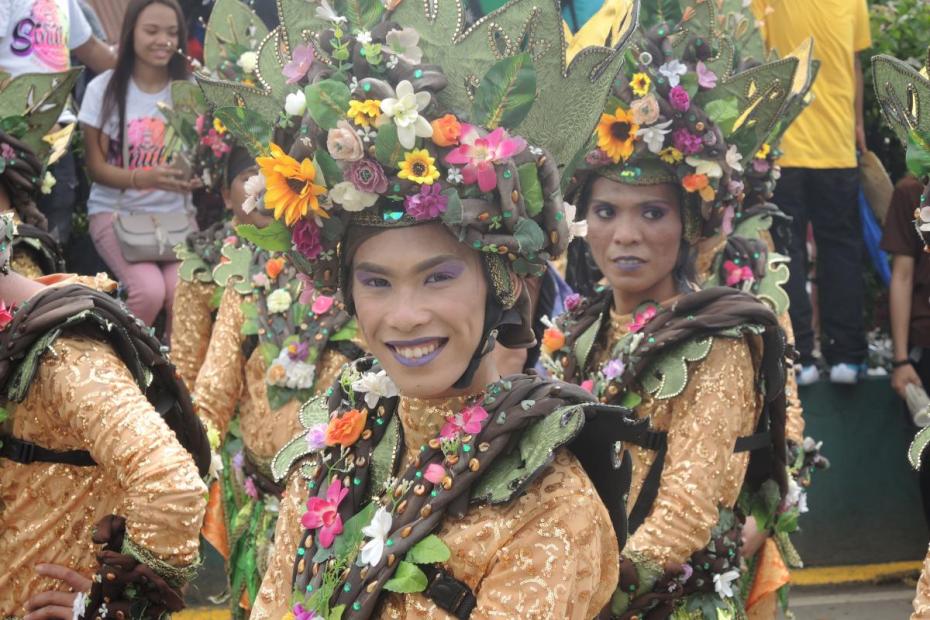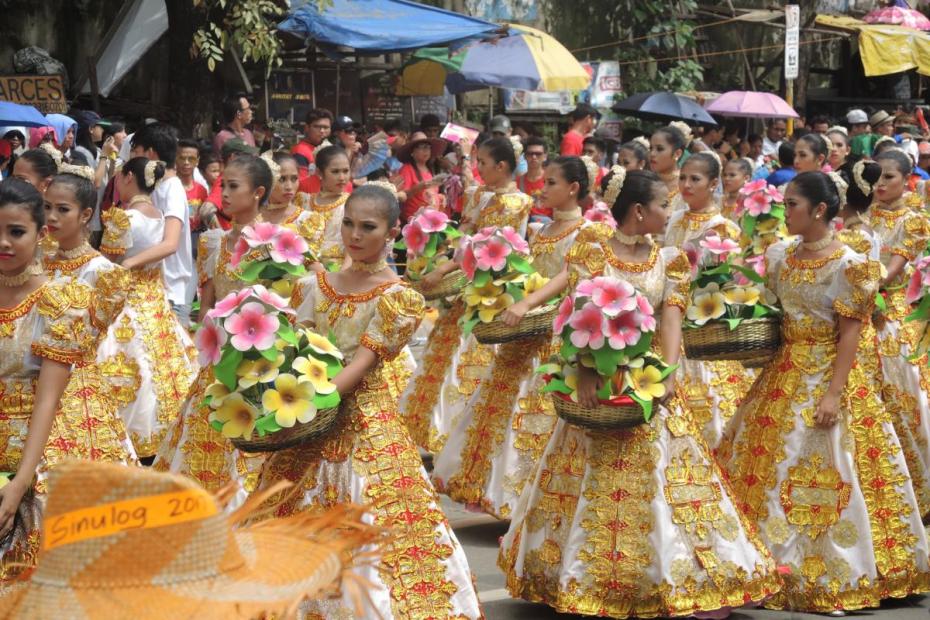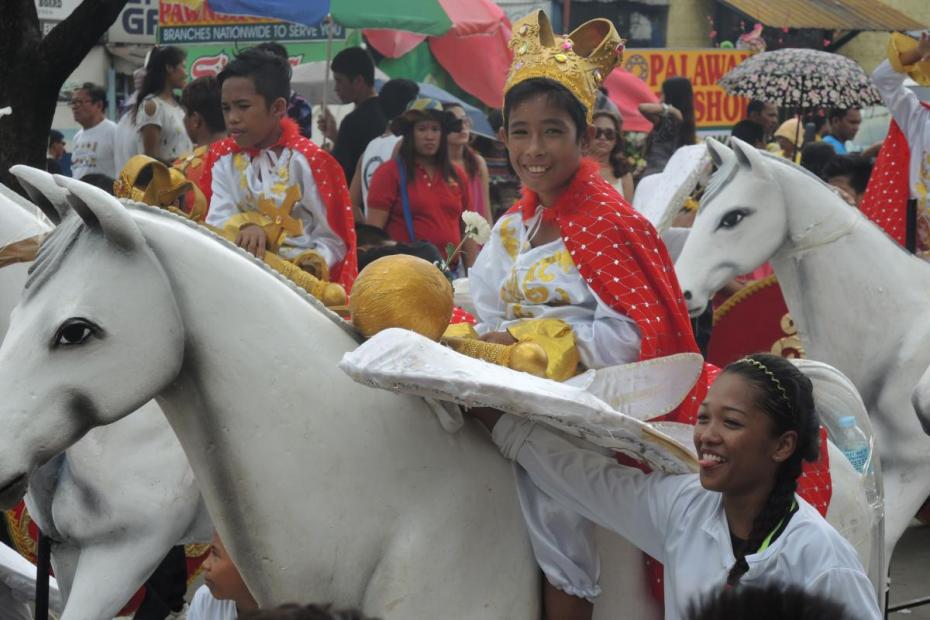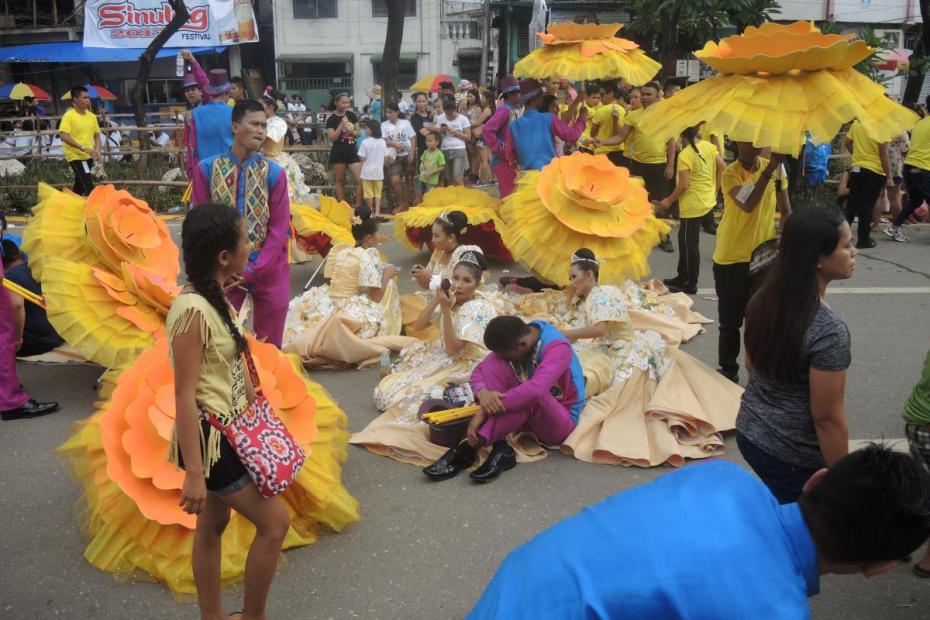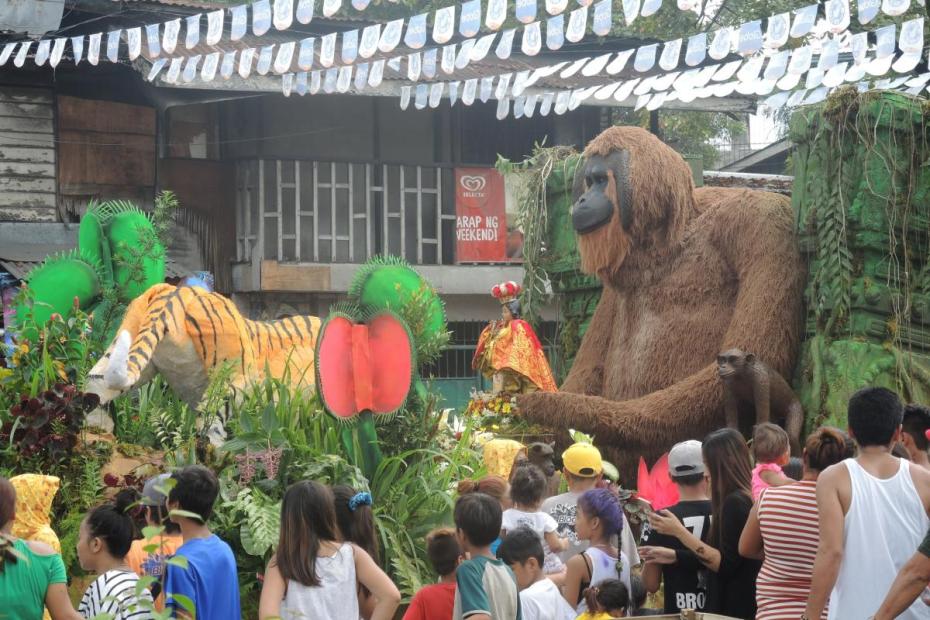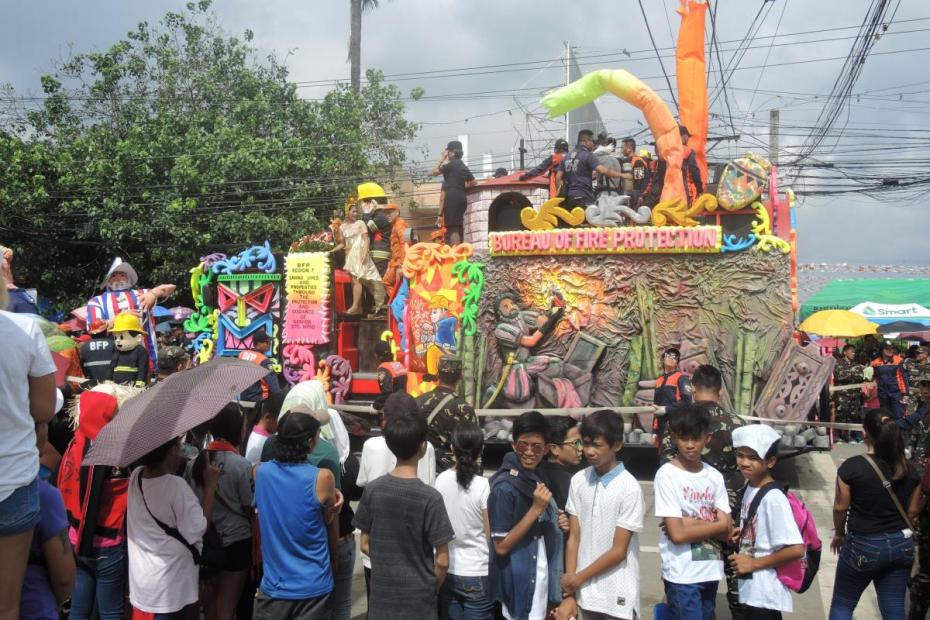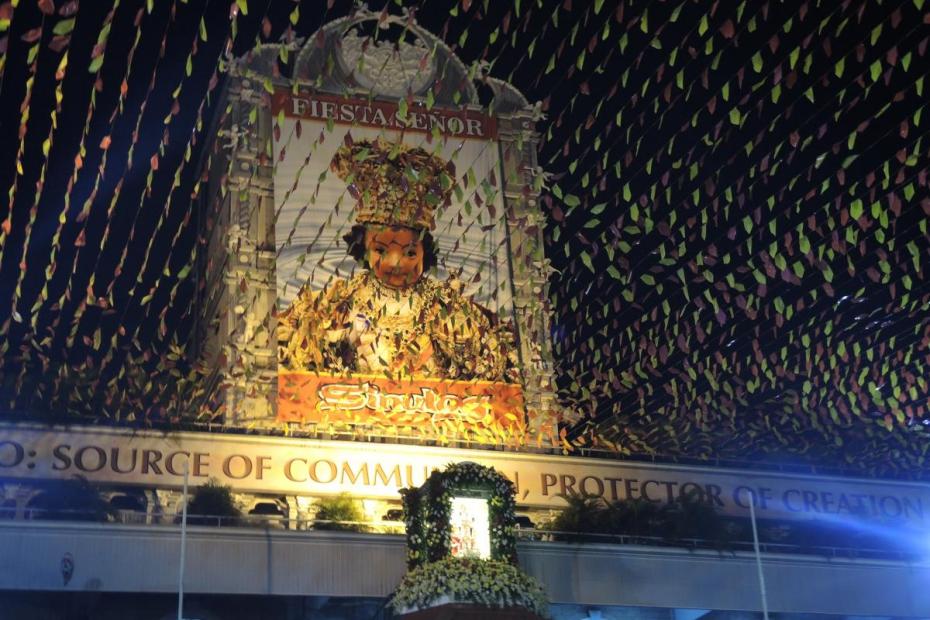Every January in the central Philippines city of Cebu, 1.5 to 3 million people gather for a series of Masses, parades, water and land processions, beauty contests, street dances and concerts, fireworks and other events that celebrate the feast of the Santo Niño — the Holy Child — of Cebu. Drawing visitors from throughout the region, the city doubles in size for the celebration, which is the biggest event of the year in Cebu. The feast, known today as Sinulog, extends more than two weeks, culminating on the weekend of the third Sunday of January, and is one of the most well attended Catholic events in the world.1 The form of the devotion stands out in that it is often manifest in a very playful enthusiasm. In distinctively Filipino fashion, it incorporates a range of civic events like beauty contests and parades into the occasion.2
Grand Sinulog Parade, Cebu, 2017
The story of the Santo Niño, and its celebration today, reminds us that Filipino Catholicism begins with, and is still to a significant degree centered on, an image.3 The Santo Niño is small: a 30 cm tall image of a smiling, European-looking boy Jesus with curly locks, with a hand raised in blessing. During the feast, he is dressed in a crown and other regal insignia, including a red and gold cape. In central Philippines, statues of Santo Niño are very common in homes, on calendars and advertising, in businesses and at street-side shrines. In January, at the time of his feast, his image is ubiquitous in Cebu.
The name sinulog refers both to a ritual dance (sinulog) inspired by and performed before the Santo Niño, reportedly for centuries, and, since 1980, to the annual citywide festival in Cebu (Sinulog) to celebrate the Santo Niño. Sinulog is two-step-forward, one-step-back dance step that is believed to predate Christianity and to take its name from Cebuano word for the way water laps on the Pahina river.
History: Santo Niño as the original source of Philippine Catholicism
As the history behind the arrival of Santo Niño is commonly told, a small Flemish statue of the child Jesus in royal pose was given in 1521 to the king of Cebu, Rajah Humabon, and his consort, Hara Humamay, by Ferdinand Magellan, leader of the Spanish expedition that first circled the globe. Delighted by the image, they were even baptized under the Spanish royal names Carlos and Juana. Soon after, though, Magellan died in battle on a neighboring island, and the Spaniards were forced out.4
When a subsequent group of Spanish colonizers returned in 1565 and did battle with the natives, the Santo Niño image was found in a hut in a wooden box, having survived the destruction of the village. Perceiving its survival as a miracle, the Spaniards adopted him as their guide and protector. On the site where the image was found, they celebrated Mass and later built the Santo Niño church, the first Catholic church in the Philippines. They also designated that the finding should be memorialized annually. Fr. Pedro G. Gallende, a historian of the devotion, notes that in the early years the feast was celebrated with a Mass, fluvial parade, feasting, bullfights and fireworks. Indeed, in 2017, the year described here, church posters referred to the Sinulog as the 452nd “Fiesta Señor” (or sometimes, in Cebuano, Senyor).5
Though the history of the sinulog dance is not entirely clear, a tradition of dancing to the sound of drums for the Santo Niño, including inside and in front of the church, is at least a century old. Locals believe that Hara Humabon herself danced a sinulog with the statue in her arms when she received it, and that she and others continued that form of devotion thereafter. Augustinian priests seem to have adopted the dance to Santo Niño devotion as an evangelization strategy.6
Awareness of devotion to the Santo Niño of Cebu and the Fiesta Señor spread beyond the Cebu area to the rest of the country after 1965, when the 400th anniversary of Philippine Catholicism was celebrated on a grand scale. The anniversary focused national attention on the site, the devotion and local practice.7 The Santo Niño church, where the original Santo Niño image is visible behind bulletproof glass, was designated that year as a minor basilica and the mother of all churches in the Philippines.
The contemporary Sinulog festival — the Sinulog parade and other major civic events tied to the feast — dates to 1980, when a regional official of the office of Youth and Sports, David S. Odilao, Jr., conceived of the Sinulog parade and invited universities to send dance teams to march and to dance. The parade grew very large, and in fact in recent years has been scaled back in size.
Weeks of celebration
Cebuanos celebrate the feast of the Santo Niño on the third Sunday of January each year, but the celebration begins long before that, and even stretches well into the week that follows. In 2017, the year recounted here, religious activities of the feast began on Thursday, January 5, a week and a half before the feast’s culmination on Sunday, January 15.8 The following day, January 16, was a day of Masses of thanksgiving, and on Friday, January 20, the feast ended with a ritual known as Hubo.
“Fun runs,” a marathon, parades, street fairs, “Sinulog festival queen” and “Ms. Cebu” pageants, “party band” concerts, fireworks, pop “idol” talent contests, department store “visual merchandising” contests and other events preceded, followed, and were interwoven with the more traditionally religious events. Many of the participants in Sinulog events like these come to fulfill a panaad (Cebuano for “promise”) to visit the Santo Niño as a show of gratitude for favors received.
On Thursday, January 5 the basilica’s celebration began with a pre-dawn, 2.3 km “Walk with Jesus” candlelight penitential procession through the streets. The procession, which drew 40,000 processants and onlookers, was probably the quietest and most restrained of the processions to follow. Processants typically carried candles or statues of the Santo Niño in the dark and prayed the rosary together aloud. The next day, Friday, was the beginning of a nine-day novena during which time there were at least 10 Masses a day in the plaza in front of the Santo Niño basilica church, every hour and a half from before dawn until after dark. Devotees lined up to pray in front of the original Santo Niño image, or simply inside the church.
In front of the church, from morning to night throughout the feast, many people visited the women known as tig sinulog to buy some candles and to ask them to pray to the Santo Niño, through dance and spoken word, for whatever needs the devotees brought. Outside the church and plaza gates, devotees left those candles at the foot of Magellan’s Cross, or burned them in grates set up in the street, or lit more standard devotional candles (sold by the church itself) in an area set up by the basilica staff.
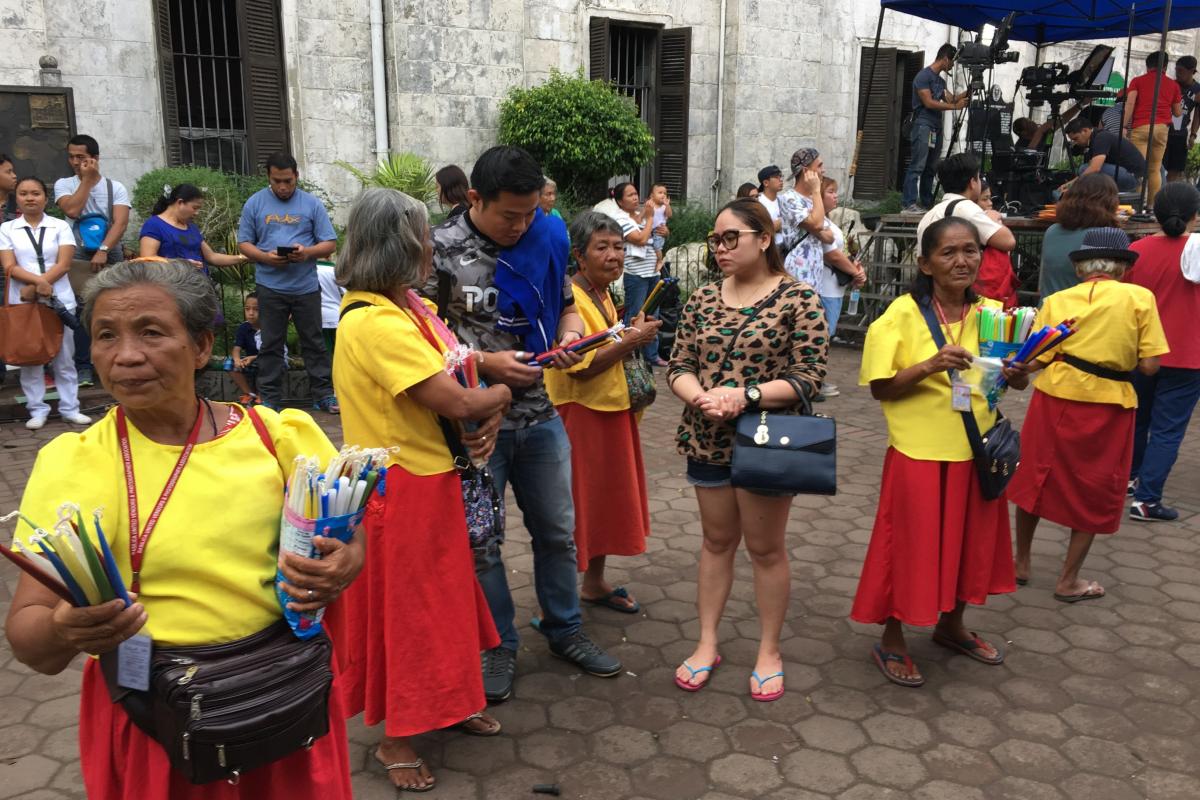
Tig Sinulog tinderas are designated women who stand outside the basilica selling candles and, on request, praying vocally and by dancing for the intentions of visitors.
As the novena progressed, the city became more and more enveloped in Santo Niño activities. On Friday, January 13, the celebration moved into high gear, though monsoon rains swept the city intermittently. The plaza and the streets around the church were crowded. The dance teams that participate in the Sunday Sinulog parade had arrived, and hundreds of thousands of out of town visitors were spread throughout the city.
That afternoon saw thousands join in a translacion, a ritual transferring an image from one shrine to another. An image of the Santo Niño and one of Our Lady of Guadalupe de Cebu were brought by automobiles from Cebu to the National Shrine to St. Joseph in Mandaue City, an urban area just west of Cebu City.9 A crowd of more than 6,000 people came to the shrine to pray. At a homily at Mass there, the preacher used the occasion to speak out against President Duterte’s campaign to hunt down and kill suspected drug dealers and users without judicial process. By bringing together the Santo Niño, Mary and Joseph, devotees said, the Holy Child was able to visit his family for the night.
In the evening there was a big contest in the stadium to choose a Sinulog Festival Queen from among the 13 young women who lead each of the dance teams at Sunday’s parade.
The fluvial procession
The major events in the first part of the day on Saturday ritualize the arrival of the Santo Niño image to Cebu, and recreate, in a highly idealized way, the baptism of Rajah Humabon and Hara Humamay, the rulers of Cebu when Magellan and the Santo Niño landed.
Long before dawn on Saturday, January 14, Cebu’s harbor began to fill with a vessels — tourist boats, ferries, fishing boats among them — for the fluvial procession that brings the image of Santo Niño back to Cebu in grand style. Boats from Bohol (a two-hour ride) and from other surrounding islands brought devotees there before dawn. Boat owners typically didn’t charge for this, but described it as an act of devotion. Some said that this was out of a sense that good things would come to them for this generosity, others suggested that it was a bit of fear that bad things could come if they charged for such a sacred event. Because of security concerns, all boats and their riders who got near the main procession were supposed to be cleared in advance, and there were plenty of harbor police boats patrolling. There were 56 officially registered boats in the procession, but by sunrise there were more than 100 such boats, and 250 more unregistered smaller boats were reported to have followed behind.10
The day before the Grand Sinulog Parade, hundreds of vessels accompany a "galleon" carrying the image of Santo Niño of Cebu back to the basilica after a visit to the National Shrine to St. Joseph in Mandaue City, an urban area just west of Cebu City.
An image of the Santo Niño, having spent the night at the Shrine to St. Joseph, arrived at the Mandaue City dock shortly after 6 a.m. By 6:45 a.m. the “galleon,” as the boat carrying the Santo Niño and priests from the basilica was called, in reference to the boats that brought Spanish conquerors, departed Mandaue City. The image of the Virgin of Guadeloupe was actually at the front, with the Santo Niño behind and above her. The boats from Cebu, Bohol and points west joined in, and crowded to get as close as was allowed to the galleon. The mood was joyous and festive as boats wove in and out, played music, and devotees sometimes danced and waved their own images of Santo Niño. The galleon docked at Cebu city at 8 a.m., followed as by successive waves of the accompanying boats who let passengers ashore.
At the pier in Cebu, the Santo Niño image was met by a woman and man dressed as Rajah Humabon and Hara Humamay, the rulers who originally received it from Magellan. Men dressed as Magellan and other Spanish soldiers joined them and the Santo Niño image in a large, buoyant processional parade from the dock to the basilica. Several troupes of dancers greeted the Santo Niño at the basilica plaza, and despite the rains Humabon and Humamay’s baptism, Catholic wedding and the first Mass in the Philippines were ritually reenacted outside in the plaza.
Later, at 2 p.m., tens of thousands of devotees had a chance to show their devotion in the streets. The “solemn procession,” over a 5.7 km route, was indeed often serious and devotional, with many participants carrying at least one image of the Santo Niño of Cebu, but at times it was often playful and joyous, as many thought was appropriate to the celebration of a young boy.
That evening Mass was celebrated in the basilica plaza by a visiting bishop, followed by an hour of traditional Sinulog dance there, then fireworks and street parties.
Following the fluvial procession, the baptism, wedding and first Mass of Humabon and Humamay are recreated in a ritualized way. That afternoon, thousands participate in a solemn procession through the streets of Cebu.
Sunday: Fiesta Señor and the Sinulog parade
On Sunday, the actual day of the feast, events began early, with a 4 a.m. “Mañanita” Mass at Basilica of the Santo Niño, followed by a pontifical Mass, and seven more Masses during the day. Liturgically, it did not seem to differ too much from the days of the novena.
The largest attended event of the day, with crowds that could never be accommodated at the basilica, was Sinulog Grand parade, an explosion of dancing and color that began and ended at the city’s sports stadium, and transformed the streets of downtown. Many roads were closed all day, and streets were mobbed with people through the day and into the night.
Though there were floats from all sorts of sponsoring civic and public associations — even a Buddhist temple — each with an image honoring the Santo Niño, the highlight of the parade was the troupes of dancers who dance tales in honor of the Santo Niño. Coming from cities and islands in the southern half of the Philippines, as far as Mindanao, the troupes were organized by municipalities or schools, and on average consist of about 100 dancers and 50 drummers. Hundreds of others were involved in their work, serving as costume-makers and support staff. Most members were students or student-aged.
At the center of each troupe’s performance, a young woman dressed in a ballgown caressed and danced with the Santo Niño in her arms, much as Hara Humamay is said to have done joyfully upon receiving the image originally. Around her, some tale relating to the Santo Niño was danced for the crowds. Some dances entailed a reimagining of pre-Christian ancestors in “native” clothes, worshipping the Santo Niño as he comes into their lives. Another enacted a story in which the Santo Niño turned people away from obsession with money to more godly values. Still others included dancers carrying candles like the generations of tig sinulog dancers who dance as part of their prayer in front of the cathedral, and who are said to have served as the inspiration for the dance parade.11
Though parade dancers claimed to be linked to the tig sinulog dances at the basilica, the level of energy and precision on the young dancers’ part, and the elaborateness of their costumes was quite a contrast from the elderly tig sinulog women’s costume and dance. The parade’s costumes were elaborate, and the designers were proud of them, but they do not seem to have any sacred status.12 Sinulog parade dancers had no problem speaking of what they do as prayer and as “performance” at the same time. As one said, “It is a performance that is at the same time a ritual.”
The parts of the dance that make it a ritual, according to them, include the way the Santo Niño image is handled and caressed, and the handling of the candles or other props that dancers use, which are usually treated as offerings.
Each troupe also performed a dance in the stadium as well, for judging purposes. Each group spent considerable time choosing a theme, and the dance was typically choreographed to tell a story. In 2017, for example, the team from Lanao del Norte, winners of the free interpretation dance prize, told a story of unity between Muslims and Christians, a hugely important issue in their part of the country. Some dancers in the troupe were in fact Muslim. Another dance began with a plea to Santo Niño to “save, value and protect our lives, rescue and educate drug addicts with their families,” while another spoke out against the ecological harm caused by dynamite fishing. A panel of judges awarded prizes, ranging from the equivalent of $2,000 to $20,000 for prizes for costumes, musicality, and dancing, both sinulog-based and free interpretation. Some people worried that the awarding of prizes complicates and cheapens the event, but others noted that it costs teams far more than they could ever win to field a dance troupe.
Newspapers cited police estimates that 1.5 million people came out for the parade on a cloudy, hot and humid day in 2017. This was half the official estimate of 3 million the year before.13 Threat of rain and unspecified security threats linked to Islamic separatist insurgencies in the south were cited as causes for lower numbers this year. Security was heavy, with police visible everywhere and helicopters passing regularly overhead. Residents were even forewarned that cell phone service would be shut down throughout the city all day.
The number of dancing contingents has dropped to 18 from a peak of 50. 14 Newspaper reports said that the shorter parade was a deliberate decision to make the parade more manageable and to handle crowd control, after incidents in 2016.15
At night after the parade, streets were mobbed throughout city, and in addition to fireworks and other celebrations, there were a number of places where parties, loud music and drinking were shut down by city.
At the basilica in the city, Masses continued in the evening, the last of which featured a long, celebratory sinulog, where clergy on the stage, and people in the plaza, enthusiastically waved images of Santo Niño and sang “Pit Señyor.”
‘Hubo’ ceremony
The Monday after the feast was designated as a day of thanksgiving, with Masses all day at the basilica, and during the week a number of civic events continued, on a smaller scale.
On Friday, January 20, five days after the feast, the Augustinian priests who have been custodians and advocates of the Santo Niño devotion celebrated the ritual known as Hubo (Cebuano for “naked” or “to undress”), when the statue was ritually undressed of its royal regalia, dipped in perfumed water, and redressed in simpler garb. The Hubo took place at a 4 a.m. Mass. Traditionally performed in a private ceremony for the Augustinians and the Cofradia (Confraternity) del Santo Niño de Cebu, a women’s confraternity, the ceremony is open to the public today. Drumbeats accompany the prayers and each step of the process. Some observers assert that the batak sa tubig — dipping the image in water — is a ritual legacy of the pre-Christian rites, possibly by Hara/Juana herself, whereby statues were dipped in water to ask the gods for something, especially to ask for rain.16 Fourteen Masses follow at the basilica that day, and the feast is finally complete.
Sacred and secular boundaries
Non-Filipino readers — and some Filipino readers — may struggle over the degree to which the whole swath of Sinulog celebrations should be considered religious, or whether it should be conceived here as a religious event at the center, surrounded by civic events. Residents of Cebu struggle with that to some degree, especially in occasional debates over whether some element of the Sinulog parade has gone too far. In a country where religious images are part of almost every imaginable setting — stores, restaurants, offices, public buildings — the boundaries are blurry to begin with. It is typically considered laudable to bring Catholic imagery into business and civic places in the Philippines.
Even as interviewees at Sinulog insist that they find religious value in the Sinulog parade as an opportunity to express religious feeling, others worry that it is becoming more of a party at times, undermining the prayerful purpose. In 2017, one of the most acclaimed groups, Sinanduloy, announced that they were going to quit dancing at Sinulog because of the rowdiness they perceived. “We are here to dance to the Niño. Our dance is a form of prayer… This [event] is no longer a prayer, but you know, it’s a party. It’s a big party.”17
The development of the Sinulog parade and other civic events interwoven with the Fiesta Señor was not understood as a secular substitute for the Santo Niño feast, but as an enhancement of it and a means of fostering both local cultural awareness and religious devotion. Sinulog developed as an event coordinated by the tourist board and the Church, generally in harmony, though occasionally with tension. In 2017, street parties, even on side streets or empty lots within 300 meters of the parade route were forbidden by the city.
According to historical accounts, as noted above, the Fiesta Señor was celebrated from the beginning with feasting and bullfights, not only with liturgies. And even in the events that might more easily be categorized as religious, commerce enters into play — such as when the tig sinulog sell candles and pray with them in front of the basilica, or the church sells its own candles, but also when, after Mass in the basilica plaza, sponsoring families’ names scroll by on a screen above the altar.
People come to the Sinulog parade, they readily reported, out of devotion to the Santo Niño, often to fulfill a panata, or vow. That the event was fun did not in itself undermine the devotion, but more readily fostered and expressed it. Dancers spoke about sacrifices made to be there, and about their parade dances as an offering. Even a journal article published in the Philippines about Sinulog took for granted that the parade, fluvial procession, street dances and activities like the beauty pageant and film-making and art contests are manifestations of “sincere devotion and strong faith to [sic] the child Jesus.”18
The point seems to be that the Sinulog parade dances, like the older forms of sinulog and the more typically devotional events, relate the dancers to the Santo Niño.19 The perspective of one member of the organizing committee is worth quoting at length:
“Some people think it is an issue that Santo Niño is being carried and danced with. But it’s part of the history that the Queen [Hara Humaway] danced with it. It was handed to her according to history. The judging [process] requires that women dancing with the statue really caress it, not just wave it around like the women on the boats do. They don’t know how to do it. You need to treat it like the one you are dancing with.
“Some people say Sinulog is a Mardi Gras, but it is not. It is a religious dance. Mardi Gras is fun before the religious season, and is a wild street dancing. It is sinful fun. Sinulog is a prayer dance. It is a dance offering. It is simple and decent. It is not a Mardi Gras. People from other countries mistake this.
“We have been aggressive in trying to remove practices that we think are too commercialized. Sometimes girls on [sponsors’] floats were dancing in too skimpy clothes. The Sinulog foundation decides who get to dance. They work with the church and give due respect to the church. But we have to add some commercial aspects and spectacle otherwise it would be boring, especially if you do it annually.”
'Calling to the Lord' in a postcolonial context
For days surrounding the feast, indeed, constantly on the Sunday of the feast — at Masses, in song and in processions — the streets of Cebu resonate with cries of Pit Señor! or Viva Pit Señor! Oddly, though, when asked what “pit” means, people tended to draw a blank. Pit is not a common word today in any other contexts. A couple of well educated interviewees suggested that it meant something like “Call to the Lord” or “Follow the Lord,” but even they professed difficulty. “We’ve lost a lot from our parents’ generations,” one said. The contemporary Sinulog celebration builds on a history of tig sinulog and other sinulog dancers, but so many specifics of that history of the dance and the celebration are, like the word pit, obscured as a result of the colonial experience.
It is hard to ignore how central the colonial experience is to the story and celebration of Sinulog. It recounts the arrival of foreign conquerors on two occasions when the encounter resulted in conflict and death. More than a century ago, Filipinos fought to free themselves from Spanish colonial rule, and value the independence they won, including from Spanish control of the Church. Yet at Sinulog the arrival of the Spaniards is reenacted in highly idealized form and celebrated, as if it only brought good things, the Santo Niño image and the faith.
At the same time, Cebuanos are aware of the event as distinctively Cebuano, as somehow their event and their history, a kind of incarnation, which may be why some Filipinos spoke of it as an extension of the Christmas season.
The basilica of the Santo Niño houses the image of the child Jesus that is said to be the one brought to Cebu in 1521. Throughout the novena and feast, pilgrims line up to visit that image, but pay no less attention to other images that copy original the Santo Niño. And many are more indigenized. As photos posted here show, the “look” of devotees’ own Santo Niño varies considerably. He is larger or smaller, a smiling boy with more European features, or is browner with black hair. He ranges from more regal to more ordinary and boyish, though almost always in blessing with some form of dress that indicates his special status.
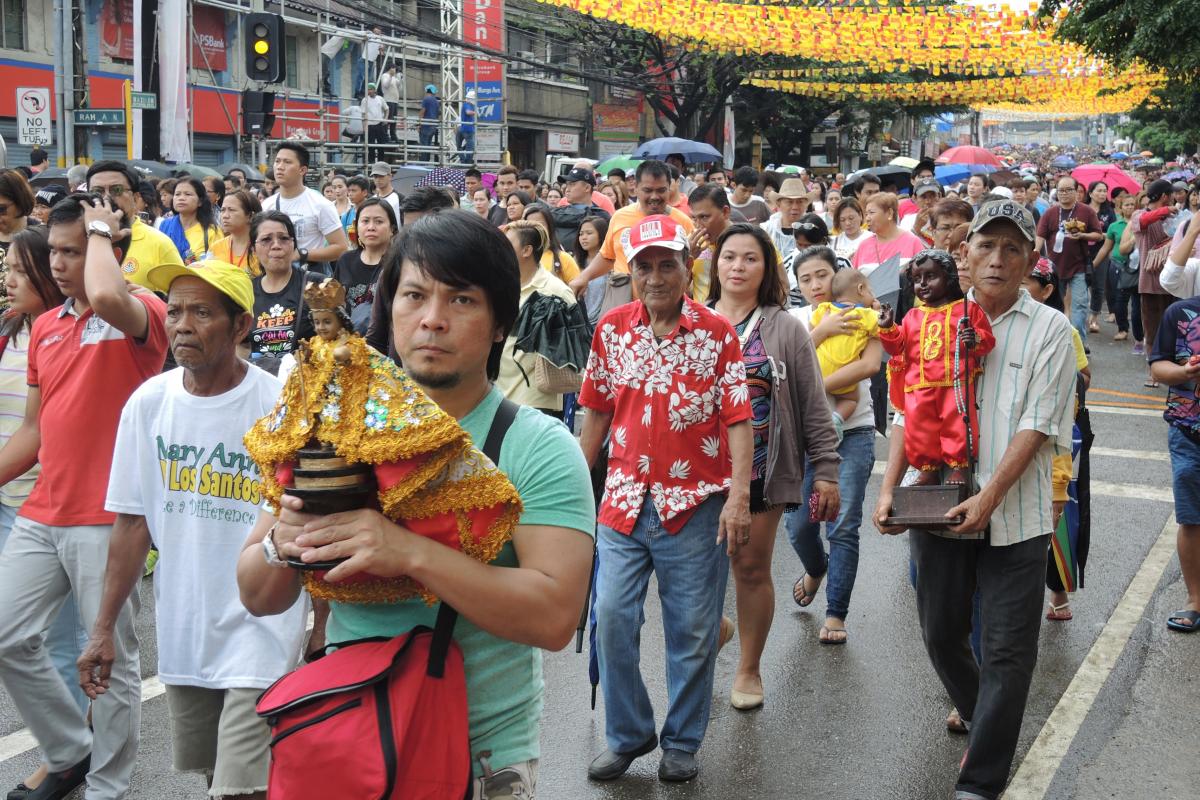
Devotees carry their own images of Santo Niño, which vary considerably.
The images carried in parades, the translacion and the fluvial procession, not to mention the hundreds of thousands visible in the hands of devotees, all seem to have a power of their own.
The primary image of the Santo Niño is quite European, but the embrace of him is distinctly Filipino, and the form of worship, outside of the Mass, is more Asian than European.
In a city where most pre-colonial elements are lost or obscured, Santo Niño is the God their ancestors chose to accept, the hinge between a pre-Christian past and Filipino present and hopeful future. People pray to him for health and family needs, for better futures, and trust that he can protect them. The rituals of Sinulog reenact the past, but are always approached as a source of protection for the future.20
Read more
Sally Ann Ness, Body, Movement and Culture: Kinesthetic and Visual Symbolism in a Philippine Community, Philadelphia: University of Pennsylvania, 1992. Based on extensive fieldwork in Cebu in the mid-1980s, this book recounts some of the popular legends about the Santo Niño and pays special attention to the form of dance by the tig sinulog and its adaptation at the parade.
- 1For estimates on attendance, see Razel Cuizon and Kevin Lagunda, “Peaceful Sinulog 2017,” SunStar Cebu, January 16, 2017, http://www.sunstar.com.ph/cebu/local-news/2017/01/16/peaceful-sinulog-2017-520360
Sinulog stands out not only because of the huge number of people who participate, but for other reasons as well. It is not the only Catholic devotion to an image of Jesus as a young boy, or even a regal young boy. Still, in the contemporary world, mass-scale devotion to a regal boy Jesus image is a phenomenon unique to the Philippines.
As many readers will recognize, the Santo Niño of Cebu is quite similar to the Infant Jesus of Prague, an image from the same era. While popular at many times in the past and still an object of devotion in a number of places in the world — even India — its following today doesn’t match the scale of devotion to the Santo Niño in the Philippines. Other Catholic images of a boy Jesus include the Santo Niño de Atocha, though his popularity seems to pale compared to what is found in the Philippines. - 2 Finally, dance, ranging from modest to almost carnival-esque, is integral to the feast and part of the way that many people pray to Santo Niño.
- 3Peter J. Bräunlein, “Image Transmission as Image Acts: Christian Images, Emotions and Religious Conversion in the Philippines,” in Transmission Image: Visual Translation and Cultural Agency, ed. Birgit Mersmann, Alexandra Schneider (Cambridge: Cambridge Scholars Publishing, 2009) 11-37. Bräunlein argues that the image, a baby boy king, allows for “conflicting hierarchies and power relations [to be] dissolved, at least for a moment,” 18.
- 4Citing sources including Antonio Pigaffetta, the original witness and chronicler of the event, Fr. Pedro G. Gallende, OSA, tells a much more complicated story, even as he cheers the arrival of the Christianity through these events. As he recounts it, Humabon and Humamay were not the first Filipinos baptized, nor were they baptized at the same time. He remarks that on becoming a Christian, Humabon was told that he now would “be able to defeat his enemies.” Fr. Pedro G. Galende, OSA, Santo Niño de Cebu 1565-2015: 450 Years of History, Culture and Devotion (Quezon City: Vibal Foundation, 2016), 31-38, 62-64.
- 5See Gallende, Santo Niño de Cebu, 57-64.
- 6Sally Ann Ness, who studied the various forms of sinulog dance and celebration in the 1980s, quotes an observer who wrote about one form of dancing for the Santo Niño at church in the 1920s, and cites other older oral traditions of sinulog dancing for Santo Niño. Sally Ann Ness, Body, Movement and Culture: Kinesthetic and Visual Symbolism in a Philippine Community (Philadelphia: University of Pennsylvania, 1992) 155-6. Claims about the antiquity of Santo Niño dances are otherwise not backed with sources. Gallende,192, simply claims that it started with Hara Humabon and continues “up to this day.”
- 7Canonically, the role of Patron belongs to the Virgin Mary and to saints, and never to Jesus, but in practical terms, strong as Marian devotion is in the Philippines, the distinction may be lost.
- 8Special thanks to Prof. Esmeralda Fortunado Sanchez of the University of Santo Tomas, and Prof. Laila Labajo of the University of San Carlos for arranging meetings and outings through the feast, and for serving as cultural guides.
- 9The image of Guadalupe is not the image from Mexico, but a version of the medieval image from the Extremadura region of Spain.
- 10Razel V. Cuizon, “Fluvial Procession Orderly, a Success,” SunStar Sunday, Cebu, January 15, 2017, p. A4.
- 11Some observers at the parade in 2017 emphasized the link to the dance of the tig sinulog, the women designated to sell candles and pray by means of dance and spoken word daily in front of the basilica. Ness indicates that another tradition, of troupe dancers performing Santo Niño sinulog in private settings, also contributed. Ness, Body, Movement and Culture, 155-198, 219-225. Ness refers to the tig sinulog in her book as sinulog tinderas, but Cebuanos interviewed for this study were confused by the term and said it was never one they would use.
- 12Neither do the tig sinulog dancers’ dresses at the basilica have sacred status. Formerly they dressed in ordinary dresses. For the feast they were in the red and yellow colors of the Santo Niño’s clothes, primarily, it seems to help identify them.
- 13“Sinulog 2017: United in Prayer and Dance,” Cebu Daily News, January 16, 2017, p. 1. In an opinion piece in the SunStar News, Publio Briones III takes to task prior estimates by other sources of as many as 8 million people, he suggests that even the 2016 police estimates of more than 3 million are unsupportable, and that a more scientifically accurate way of counting needs to be employed. Publio Briones III, “Sinulog Crowd Estimates,” SunStar News, January 15, 2017, p. A13.
- 14“Fewer Dancing Contingents,” SunStar Sunday, Cebu, January 15, 2017, p. A10. But note that the same page lists 23 groups, half Sinulog-based, half free interpretation.
- 15Razel V. Cuizon and Kevin A. Lagunda, “Peaceful Sinulog 2017,” SunStar Cebu, January 16, 2017, p. A4.
- 16One account of this, and an attempt to provide a Christian theological explanation, is at https://augustinianchurches.wordpress.com/2014/08/24/hubo-ritual-at-the-end-of-the-festival/.
- 17Jean Marvette A. Demecillo and Vania Mae Lim, “Sinanduloy to Quit Sinulog,” The Freeman, Cebu City, January 12, 2017, p. 6
- 18Norly C. Ibones, Janryl S. Oliverio, Harryl Jay L. Ondo, Hera Filipina C. Tagpuno, and Reynaldo Inocian, “Señor Santo Niño Devotees' Lived Experiences in a Fluvial Parade” Asia Pacific Journal of Multidisciplinary Research (2016) 4, 181.
- 19On the centrality of relation as the core cultural value of sinulog, whether through dance or otherwise, see Ness, Body, Movement and Culture, 224.
- 20Ness notes that in her many interviews, the sinulog was never performed for the dead. It was a "rite for the living, a means of coping with day-to-day events and circumstances.” Ness, 94.
